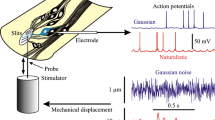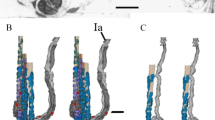Abstract
1. This communication describes, in the tonic stretch receptor organ (RM1) of crayfish, the inhibitory fibre's influence upon sensory modulated discharges. Periodic trapezoidal length changes were imposed, and rate plots of the afferent discharges were compared without inhibition (C) and with inhibition, either irregular (P) or regular (R), and at different rates. 2. Inhibition changed all sensory response components. Changes were dependent on issues as inhibitory rates and patterns, RM 1 discharge modulations, and pre-post-synaptic rate ratios. The most common effect was rate reduction, usually non-uniform along the cycle and with little evidence of proportionality. Saturation, i.e., inefficacy of shifts around extreme inhibitory rates was apparent. Rate increases occurred also. Accelerations were manifest by increased phasic lengthening response slopes and heights, by “faster inhibitor-faster inhibited” relations, or by postinhibitory rebounds. 3. Irregular inhibitory discharges (i) favoured variability along individual and average cycles, (ii) favoured monotonicity, (iii) rarely silenced the RM 1, and (iv) reduced without eliminating nonproportionality and saturation. 4. Regular inhibitory discharges showed the most clear-cut nonmonotonicities and saturations silencing the RM 1 effectively. Furthermore, they included characteristic epochs where (i) the RM 1 spike slid across the invariant interinhibition intervals, (ii) intervals recurred in stereotyped sequences and (iii) rate ratios had special values (e.g., 1:1, 1:2). Thus, the gradually decaying slope of the control adaptation after the lengthening transient was changed into a staircase profile or a sudden drop to a constant plateau. 5. Inhibition changed phasic and tonic sensitivities, usually refucing them (phasic decreasing less than tonic); increases, joint or individual, occurred also. The fidelity with which the rate plot reproduced the sensory stimulus was modified in many ways (e.g., by conversion into a phasic prototype, or into a system with perfect reproduction, etc.). Changes depended on the inhibitory discharge, and on the stimulus features. 6. These experiments have implications in two fields. In that of synaptic rate effects, (i) they confirm that the inhibition repertory includes slowings (predominant here) and accelerations, plus special effects, and (ii) they demonstrate extensively their dependence on the post-synaptic features. In the field of sensory control, they note sensory-synaptic interactions that, in intact animals, must arise but whose characteristics and roles can only be conjectured about.
Similar content being viewed by others
References
Alexandrowicxz JS (1967) Receptor organs in thoracic and abdominal muscles of crustacea. Biol Rev 42:288–326
Barrio LC (1986) Interacciones Dinámicas Excitatorio-Inhibitorias en una Neurona Marcapasos. (PhD thesis): U.A.M., Madrid
Barrio LC, Buño W Jr (1984) Dynamics of excitatoryinhibitory interactions in the slow-adapting stretch receptor organ of crayfish. Neurosci Lett [Suppl] 18:s258
Barrio LC, Buño W Jr (1986) Biphasic effect of synaptic inhibition and hyperpolarizing current pulses in an isolated neuron. Neurosci Lett [Suppl] 26:s495
Barrio LC, Buño W Jr (1988) Dynamic analysis of sensoryinhibitory interactions in the crayfish stretch receptor. J Neurophysiol (submitted for publication)
Brown HM, Ottoson D, Rydqvist R (1978) Crayfish stretch receptor: an investigation with voltage-clamp and ionsensitive electrodes. J Physiol (London) 284:55–179
Buño W Jr (1984) Information processing by pacemaker neurons. In: Reinoso-Suarez F., Ajmone-Marsan C (eds) Cortical integration. Basic, archicortical and cortical association levels of neural integration. Raven Press, New York, pp 37–51
Buño W. Jr, Fuentes J, Segundo JP (1978) Crayfish stretchreceptor organs: effects of length-steps with and without perturbations. Biol Cybern 31:99–110
Buño W Jr, Bustamante J, Fuentes J (1983) Modifications of dynamic and static behavior by small-length perturbations in crayfish stretch receptor organ. J Neurobiol 14:177–194
Buño W Jr, Fuentes J, Barrio LC (1987) Modulation of pacemaker activity by IPSP and brief length perturbations in the crayfish stretch receptor. J Neurophysiol 57:819–834
Calvin WH, Hartline DK (1977) Retrograde invasion of lobster stretch receptor somata in control of firing rate and extra spike patterning. J Neurophysiol 40:106–118
Eckert RO (1961) Reflex relationships of abdominal stretch receptors of the crayfish. I. Feedback inhibition of the receptors. J Cell Comp Physiol 57:149–162
Jansen JKS, Nja A, Ormsad D, Walloe L (1970a) Inhibitory control of abdominal stretch receptors of the crayfish. III. The accessory reflex as a recurrent inhibitory feedback. Acta Physiol Scand 81:472–483
Jansen JKS, Nja A, Walloe L (1970b) Inhibitory control of the abdominal stretch receptors of the crayfish. I. Existence of double inhibitory feed-back. Acta Physiol Scand 80:420–425
Kandel ER, Frazier WT, Wachtel H (1969) Organization of inhibition in abdominal ganglion of Aplysia. I. Role of inhibition and disinhibition in transforming neural activity. J Neurophysiol 32:496–508
Kohn AF, Segundo JP (1983) Neuromime and computer simulations of synaptic interactions between pacemakers. Mathematical expansions of existing models. J Theor Neurobiol 2:101–125
Kohn AF, Rocha AF, Segundo JP (1981) Presynaptic irregularity and pacemaker inhibition. Biol Cybern 41:5–18
Kuffler SW, Eyzaguirre C (1955) Synaptic inhibition in isolated nerve cell. J Gen Physiol 39:155–184
Liestol K (1983) The effect of the time pattern of presynaptic impulses on the transfer of information across an inhibitory synapse. Acta Physiol Scand 117:227–232
Nakajima S, Onodera K (1969a) Membrane properties of the stretch receptor neurons of crayfish with particular reference to mechanism of sensory adaptation. J Physiol (London) 200:161–185
Nakajima S, Onodera K (1969b) Adaptation of generator potential in the crayfish stretch receptor under constant length and constant tension. J Physiol (London) 200:186–204
Nakajima S, Takahashi K (1966) Post-tetanic hyperpolarization and electrogenic Na pump in stretch receptor neurone of crayfish. J Physiol (London) 187:105–127
Perkel DH, Schulman JH, Bullock TH, Moore GP, Segundo JP (1964) Pacemaker neurons: effects of regularly spaced synaptic input. Science (NY) 145:61–63
Schulman JH (1969) Information transfer across an inhibitory to pacemaker synapse at the crayfish stretch receptor. (PhD thesis). University of California, Los Angeles
Segundo JP (1979) Pacemaker synaptic interaction: modelled locking and paradoxical features. Biol Cybern 35:56–62
Segundo JP (1987) Synaptic rate effects. In: Adelman G (ed) Encyclopaedia of the neurosciences. Birkhäuser, Boston
Segundo JP, Diez Martinez O (1985) Stretch receptor responses to sinusoidal stimuli depend critically on modulation depth and background length. Biol Cybern 51:375–382
Segundo JP, Tolkunov BF, Wolfe GE (1976) Relation between trains of action potentials across an inhibitory synapse. Influence of presynaptic irregularity. Biol Cybern 24:167–179
Sokolove PG, Cooke IM (1971) Inhibition of impulse activity in a sensory neuron by an electrogenic pump. J Gen Physiol 57:125–163
Swerup C, Rydqvist B, Ottoson D (1983) Time characteristics and potential dependence of early and late adaptation in crustacean stretch receptor. Acta Physiol Scand 199:91–99
Terzuolo CA, Purple RL, Bayly E, Handelman E (1968) Postsynaptic inhibition: its action upon the transducer and encoder systems of neurons. In: Structure and function of inhibitory neuronal mechanism. Pergamon Press London, pp 261–285
Torras i Genis C (1985) Temporal-pattern learning in neural models Springer, Berlin Heidelberg New York
Van Harreveld A (1936) A physiological solution for fresh water crustacean. Proc Soc Exp Biol Med 34:428–432
Vibert JF, Davis M, Segundo JP (1979) Recurrent inhibition. Influence upon transduction and afferent discharges in slowly adapting stretch receptor organs. Biol Cybern 33:167–178
Vibert JF, Caille D, Segundo JP (1985) Examination with a computer of how parameter changes and variabilities influence a model of oscillator entrainment. Biol Cybern 53:79–91
Wilkens LA, Wolfe GE (1974) A new electrode design for en passant recording. Comp Biochem Physiol 48:217–220
Author information
Authors and Affiliations
Additional information
Visiting Professor from the Department of Anatomy and Brain Rescarch Institute, University of California, Los Angeles, USA
Rights and permissions
About this article
Cite this article
Barrio, L.C., Buño, W. & Segundo, J.P. Sensory-synaptic interactions in crayfish stretch receptor neurones. Biol. Cybern. 59, 385–394 (1988). https://doi.org/10.1007/BF00336112
Received:
Issue Date:
DOI: https://doi.org/10.1007/BF00336112




